Mysuru: A Look at its Past… By Gouri Satya, Sr. Journalist
Not only the Maharajas and the benevolent ones, but even a Dewan also built an Agrahara in Mysore during the days of the Wadiyars. We have streets and roads built by the Dewans or named after them. But no Dewan has built an Agrahara except this Dewan, which is also named after him. However, the Agrahara built by him had only a few houses, unlike most of the other Agraharas in Mysore.
After Mysore became the residential city of the Wadiyars in 1799, the city began to witness expansion suiting the increase. The work of providing houses for those who migrated to the royal city, attracted by the support and encouragement given by the King, had commenced during the reign of Krishnaraja Wadiyar III alone. New Agraharas came up during his reign, as he and his queens took it up as an act of charity. Gradually, Mysore had begun to see the happier days, people settling down under the patronage of a benign Maharaja.
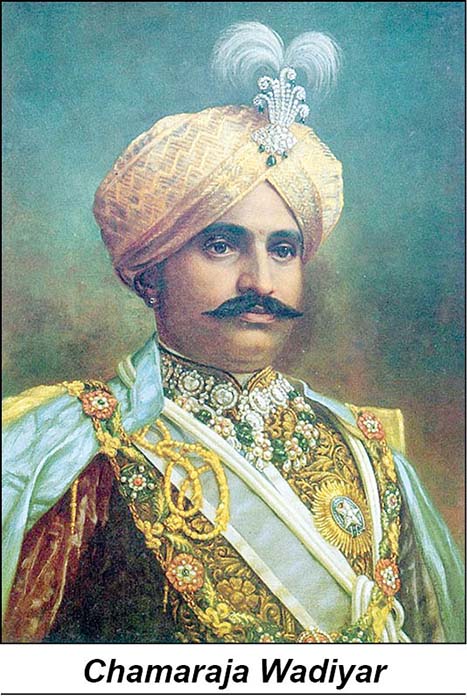
The growth of Mysore became evident during the reign of Chamaraja Wadiyar X, who succeeded after the demise of Maharaja Krishnaraja Wadiyar III, most known as Mummadi Krishnaraja Wadiyar in 1868.
A traditional city of small size began to take a turn towards modernity. In this task, two competent Dewans, Rangacharlu (1881-1883) and Seshadri Iyer (1883-1901) ably assisted the Maharaja, playing a significant role in bringing about reforms in administration and initiating schemes and projects that laid the foundation for a progressive State.
The construction of the Railway line linking Bangalore with Mysore was one such major achievement. It had been taken up as 1877-78 famine-relief work. It was commissioned in 1882 when Rangacharlu was the Dewan. It provided connectivity up to Madras, the present Chennai. Chennai-Bangalore Railway line was already existing by then. The new Railway line gave a boost to the economic growth of the State.
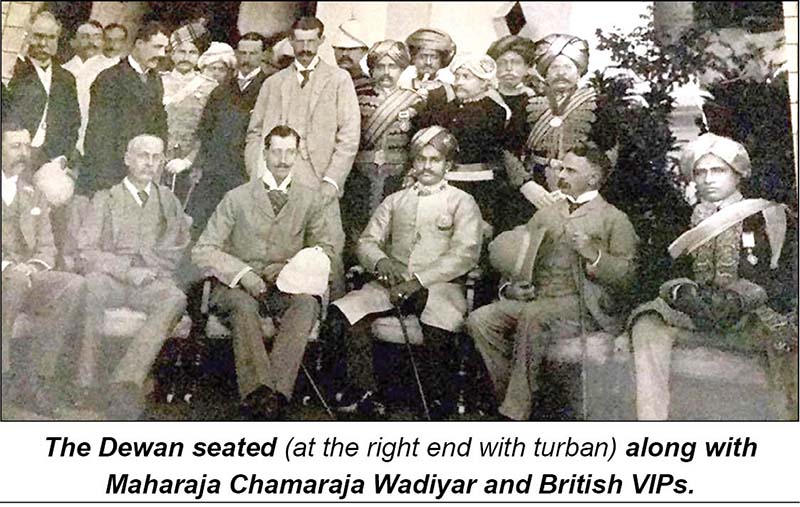
Rangacharlu, who had brought about many reforms in administration and improved the finances of the State, had proposed to extend the Railway line up to Tiptur. However, he was not destined to live long enough to carry out his ideas. He was taken ill and died at Madras (Chennai) in December 1882. Dewan Rangacharlu was succeeded by Seshadri Iyer. The Railway link to Tiptur became a reality during Dewan Seshadri Iyer’s period.
Seshadri Iyer served the State for 18 long years and was the second longest serving Dewan next to Dewan Purniah. He was Dewan to Chamaraja Wadiyar till the Maharaja’s premature death in 1894 and continued during the Regency of Vani Vilasa Sannidhana Kempananjammanni as Nalwadi Krishnaraja Wadiyar was still a minor. Seshadri Iyer retired in 1901, before the termination of the Regency and installation of Nalwadi in 1902, and passed away soon after. During his period, the Kingdom saw progress in different directions including transport, irrigation, mining and electric power.
Kumarapuram Seshadri Iyer was born on June 1, 1845, in a Tamil-speaking family at Kumarapuram, near Palghat, in the present Kerala State then in Madras State. His parents were Ananthanarayanan Iyer and Venkatalakshamma. After his early education in Kozhikode (Calicut), he graduated from the Presidency College in Chennai. He had begun his official life in 1866 as a Translator in the Collector’s Office in his native town of Calicut in the Madras Presidency.
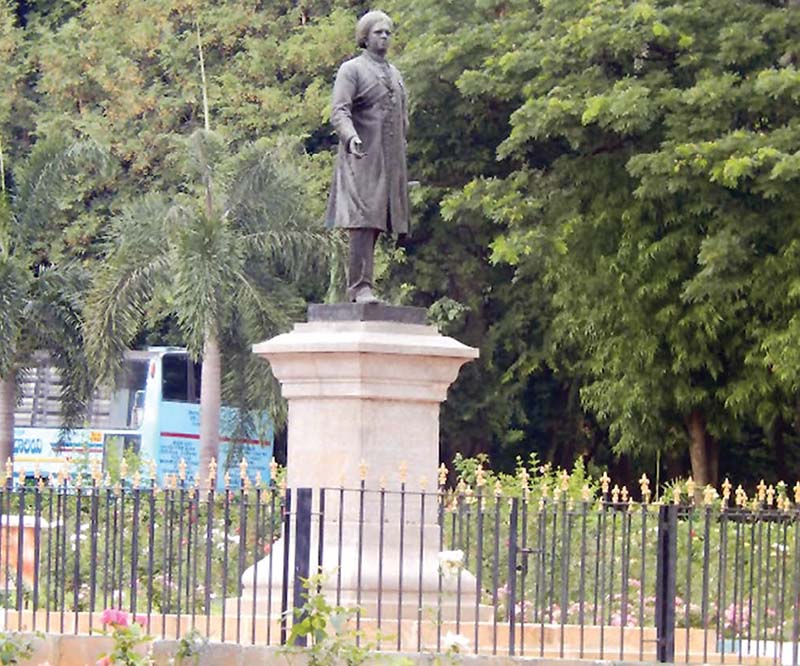
There being need in Mysore for the services of capable English-knowing men, Seshadri Iyer, at the suggestion of Rangacharlu, was appointed Judicial Sheristadar in the Superintendent’s office at Mysore, which he joined on 30th October 1868. With this, he entered the services in the Mysore kingdom. After he took the E.L. Degree of the Madras University in 1874, he was appointed Deputy Commissioner and District Magistrate of one of the districts in 1879, and from August 1881 he was placed on special duty in the Dewan’s office under Rangacharlu.
Seshadri Iyer entered upon his new duties as Dewan with great earnestness and wisdom and proved himself a man of undoubted talents. He set right the disorganised finances of the State and plugged the deficit. The finances needed to be set right first for improving the efficiency of the administration. Realising that agriculture was mainly dependent on tanks which were in a bad shape, a new Public Works Division was formed. The improvement in irrigation and restoration of tanks and river channels was entrusted to it.
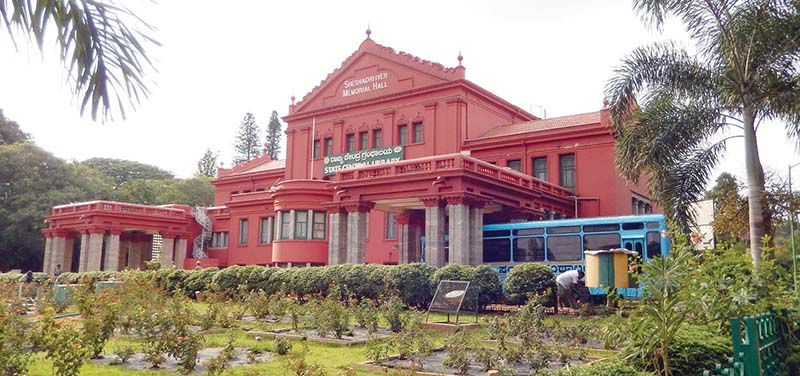
In 1900, he initiated the first hydroelectric project in Asia at Sivasamudra to harness the waters of the Cauvery falls. But unfortunately, he could not be a witness to its commissioning in 1902. The ill health compelled him to retire and his end came soon after in 1901.
The completion of the power scheme and transmission of power to the Kolar Gold Fields (KGF) for the first time, drawing the longest transmission line in the world at that time, was hailed as “Thus one of the greatest and most recent developments of modern science was successfully carried out in Mysore and to the Maharani-Regent and her advisers belonged the credit of carrying out this bold enterprise.”
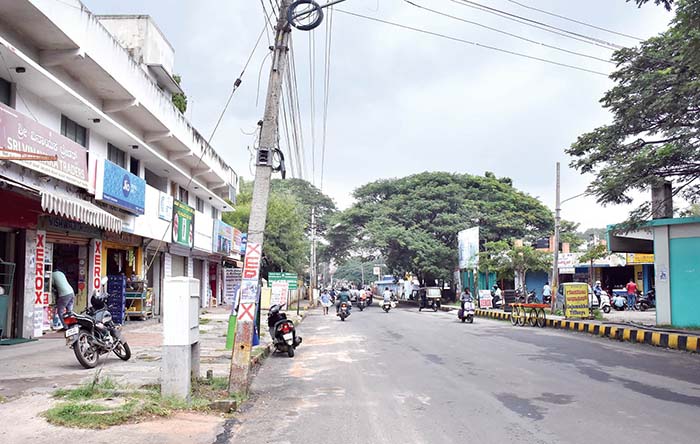
During Seshadri Iyer’s administration, a number of works to put Bangalore on modern lines were initiated. In order to decongest the thickly crowded areas which frequently saw the outbreak of the dreaded plague in Bangalore, the visionary Administrator and Statesman developed Basavanagudi and Malleswaram to rehabilitate those who had lost their houses. This brought in new industries and businesses boosting the prosperity of Bangalore. As a result of the various initiatives undertaken by him, Seshadri Iyer became popular as the “Maker of Modern Bangalore.”
Besides the construction of the Marikanave dam in the arid district of Chitradurga and the reconstruction of the fire-destroyed Palace, a number of other useful measures were initiated during the tenure of Seshadri Iyer. In all these, he had a major role to play as Dewan.
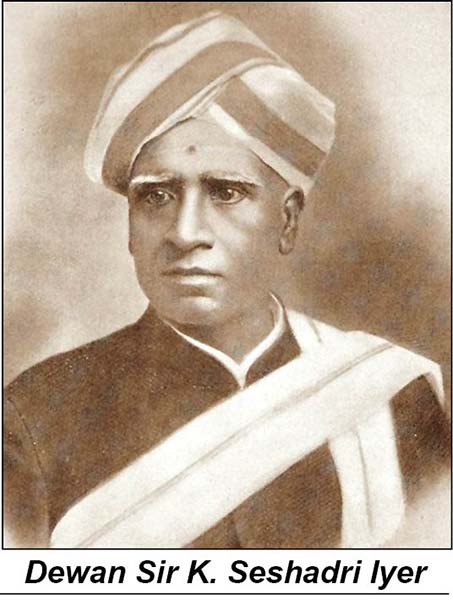
Dewan Sir K. Seshadri Iyer, a man who was responsible for making Mysore a modern kingdom with many achievements to his credit, has left permanent landmarks in his memory. He “possessed a powerful intellect and a strenuous will. During his long period of office, he rendered various useful services to the country of his adoption and achieved distinction as a Statesman of Indian repute.”
Later, a statue was raised and a building known as the Seshadri Iyer Memorial Hall in Cubbon Park at Bangalore to commemorate his services was constructed. Today, it houses the Bangalore Central Library, his statue standing in front of it.
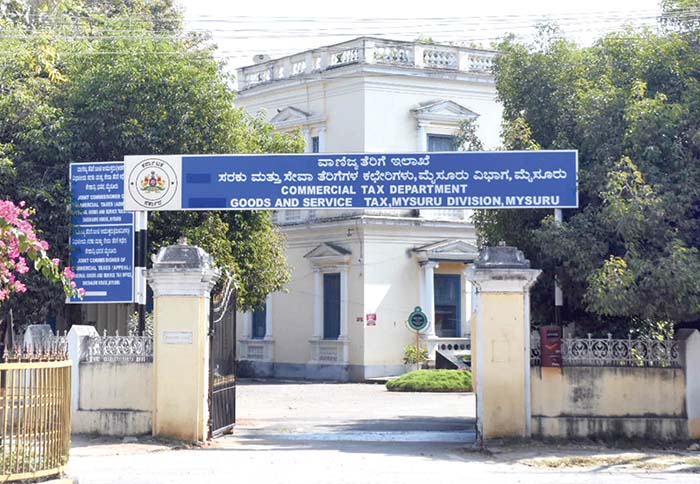
Sir Seshadri Iyer built an Agrahara in Mysore and Prof. Venkatachala Sastry, veteran scholar, writes in his booklet on Ambale Annaiah Pandit, “emulating Ambale Annaiah Pandit, Seshadri Iyer built an Agrahara of nine houses and donated them to Brahmins with ‘Vritti’.”
The Dewan’s Agrahara today has come to be popularly called ‘Dewan’s Road’, while its original name was ‘Sir Seshadri Iyer Road’. It stretches from Kantharaj Urs Road to Bannimantap Road, near the Bamboo Bazar area. On this road stands the historic ‘Kumara Bhavana’ where he resided when he was serving the State. The Offices of the Commercial Taxes are accommodated in this heritage building now.



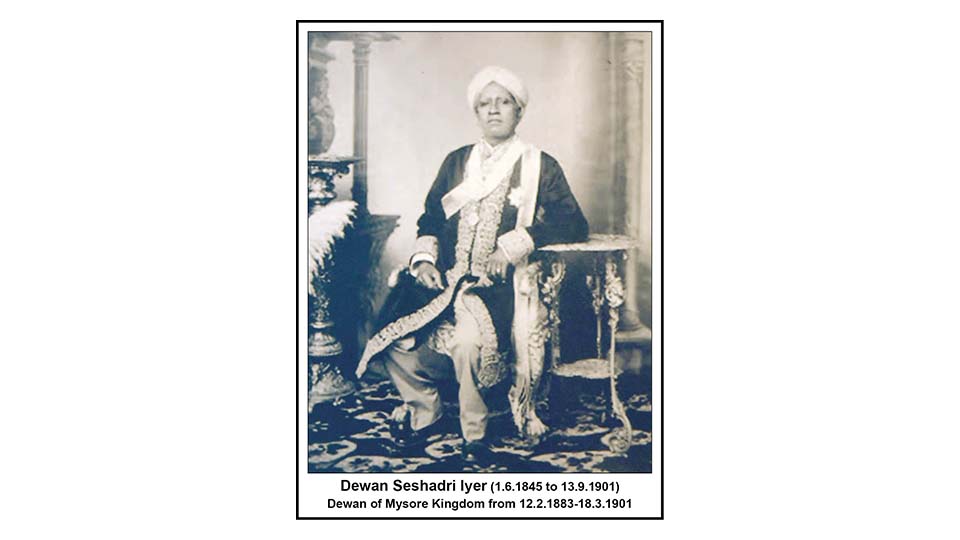




The problem with Gauri Satya’s anecdotes and articles is that he seldom acknowledges that the real power was with the British Viceroy who ruled India, and as such credit must be given to the British Viceroy and his representatives in the State, who should be admired for their vision as rulers, while discussing Wadiyars and |Dewans, who were merely the ruled.
Gauri Satya should understand while praising Wadiyars and Dewans, nothing could have been achieved without the British Viceroy of the day giving permission to it. Indeed Dewans interacted daily with teh British Resident in Bangalore, who represented the British Viceroy of the day.
In fact, the British allowed freedoms to Wadiyars and Dewans, to carry out the developments in the State, after the British viceroy was consulted and agreed to them.
That Photograph, where Gauri Satya simply titles as British VIPs, were really the British officers that the British Viceroy designated who held powers to approve the projects /developments on their visits. A few could be from London, on the orders of the British Monarch on special occasions, meeting the British Viceroy first in New Delhi, and then the Dewan later in Bangalore.
Seshadri Iyer and indeed other Dewans including Sir MV were Bangaloreans- they lived, and worked in Bangalore. It was because, the British Resident-the representative of the British Viceroy of the day, who was the boss of Wadiyrar and Dewans of the day, lived in Bangalore Cantonment with the British Garrison. That meant that the house in Dewan’s Road, was where Seshadri Iter used to stay during his visits to Mysore. He was a Bangalorean.
Sesahdri Iyer developed Bangalore, perhaps envisaging as he future capital of the State in his mind, as he knew Mysore was distant and isolated. Kengal Hanumanthaiah who is blamed for shifting the capital to Bangalore when he was the CM, simply carried out what Sheshadri Iyer wanted.
Sheshadri Iyer, a Tamilian, encouraged many Tamilian professionals and administrators to migrated to the State – there were engineers who hailed from his native Palghat, who were employed in the Shivasamudram Hydro Electric project development. My father explained this to me, as he knew quite a few of them.
Many Tamilians from Tamil Nadu too migrated to Bangalore in Seshadri Iyer’s time-like TP Kailasam’s father, some others went to work in Mysore Palace, like RK Narayan’s father.
Interesting that Nalwadi Krishnaraja Wadiyar, spent most of his time in Bangalore Palace, arriving to Mysore during Dasara. He died in Bangalore.
I would hence strongly suggest to Gauri Satya, to focus more on Bangalore since the days of Seshadri Iyer or even before, as it was the de facto Royal city.
Moving the focal ;point of Wadiyar’s rule from Srirangapatna, after thye defeat of Tipu Sultan, and the subsequent construction of a grand palace in Mysore, this city in the years followed was the capital of the State, but felt never like it. For a start, the railway line between Bangalore and Mysore was metre gauge ,and hence Mysore was sitting in a cul-de-sac.somewhat isolated and functioning only as a titular capital . One wonders whether Seshadr Iyer saw this city as a quaint place of Agraharas, and nice Royal edifices , where as Bangalore in his time was being developed as a metropolis., giving the impression that Seshadri Iyer and other Dewans saw Mysore merely as decorative heritage place. Hence, it remained a docile, serene and a very isolated city, with poor connections to Bangalore and other districts. the train line stooped at Chamarajanagar, with ghats blocking onward link to Satyamangalam , in Tamil Nadu. It was for all purposes was considered as a Wadiyars’ relic!
A visit to Bangalore as nearly 4 hours of train journey from Mysore during those days in early 1950s,when Mysore was still the capital exemplified the above relic aspect of Mysore, where as Bangalore felt like the real capital with administration units of importance, just like one felt visiting Madras and Bombay, then.
In a way, the Dewans like Seshadri Iyer, followed the mind set of the British rulers, that In Britain, Windsor, a small town, 20+ miles from London was the seat of British monarchy with its ancient palace, like Mysore, where as London wthe capital with its Buckingham Palace looking more like a large administrative building, like Bangalore palace.
One should read this Agrahara article in the context of Mysore as the Wadiyars’ relic. Seshadri Iyer did not create such an Agrahara in Bangalore, although, one might argue the Seshadripuram area came close to that concept,. But its +layout was very different.
Two visions of Seshadri Iyer, one quaint outlook for Mysore, but an outlook of metropolis, modern , then, for Bangalore
All Dewan made Bangalore as their place of permanent residence, and all of them viewed Mysore and Bangalore very differently indeed, with the fomer a sa symbol of ancient Wadiyar dynasty..
For Mr Gauri Satya to ponder:
I was born and brought up min Mysore, and spent my primary, middle school, high school and engineering college years-beginning from the late 1940s.
While Sir K Seshadri Iyer was interested to build an Agrahara in Mysore- a cheek to jowl space, where match box size houses are closely joined together, he was developing Bangalore as a grand city with electric street lighting and extensions that Mysoreans can only envy.
The only features which stood out in Mysore, as a so called Royal place-was Mysore Palace and Chamudi Hill. In other ways, Bangalore, if one visited there in early 1950s- I had in my primary school years., Then one ,would have been struck with awe – iconic red brick buildings, Lalbagh, bull temple road-a wide vista etc.. , a real Royal City in its grandeur.
The impressive red brick Central College, a science education centre, the red brick Government engineering college, now UVCE, the IISC, all in later years after this Dewan, were possible, because of this Dewan’s foresight for Bangalore.
One wonders why Bangalore-Mysore rail link had to be metre gauge since its inception?
What purpose , a relatively isolated Mysore city would serve as the capital, when even Nalwadi Wadiyar was spending so much time in Bangalore? Yes, Mysore was a nice little patch of a place, my native place, so calm. That is all.
A comparison with Devaraja Market and KR Market in Bangalore, would have revealed the superior KR Market features of wide selection of fruits and vegetables some 50% cheaper than one could find them in Devaraja Market. Howabout Russell Market?
I am stating the above, because Sir K Seshhadri Iyer planned Bangalore city in a modernist way, leaving out Mysore, as a psoter says above, a ‘a quaint’ place full of Agraharas!!
My dear friend says: Seshadri Iyer served the State for 18 long years and was the second longest serving Dewan Next to Dewan Purniah.
I am afraid he is taking Purniah’s tenure as Dewan under the usurpers too ! Otherwise he served Mummadi from 1799 to 1811= 12 years only. Whereas Mirza served from 1926-1941 = 15 years and Seshadri Iyer served only between 1883 to 1900 ( officially up to 1901 though he was on leave in the intervening period) = 17/18 years ! This undoubtedly being the longest tenure!
With regard to comments by Jalandhara: It is absurd to say the least ! If Viceroy indeed or Dewan’s were responsible why was the other 500 and odd Rulers in India did not deliver the goods ?
Hello Raja Chandra
Let me reiterate the fact: British ruled India, through a British Viceroy, , which meant that they had absolute power-nothing moved without the Viceroy’s permission.
Indian Royalty-the Maharajahs were simply the subordinates of the British Viceroy, with no independent power to exercise.
The British defeated Tipu Sultan, and freed the young Wadiyar and encouraged him to rule Mysore, under them. Hence, they had special interest in Mysore thriving.
Now, those 500 rulers you mention , most of them were very minor so called Maharajahs. with the exceptions of the Nawab of Hyderbad, the Rajasthan Royalty, the Travancore core Cochin Maharajahs, and of course Mysore Wadiyars.
Where there were Dewans of Foresight, you mentioned the three\; Purniaih, Seshadri Iyer and Mirza Ismail, and I will add the most visionary of them all: Sir MV, Mysore flourished. Other Dewans were there too, who are easily forgotten. These Dewans were like modern CEOs getting project plans drawn, finding resources etc.. which necessitated the consultations and approvals of the British Viceroy, their boss-the chairman.
One cannot get a better example than the Maharajah of Travancore and Cochin picking A Dewan of immense capability-Sir C P Ramaswamy Iyer, to explain how a very capable Dewan can achieve so much for the state, working with the British power structure in India.
I suggest you to read Sir C P Ramaswamy Iyer’s Books , where he explains clearly, how a Dewan acting with the blessings of The British Viceroy could make a difference. I suggest you start with his book: ” Biographical Vistas”.
Mummadi cannot by himself conjure up the Shivasamudram Hydroelectric Power Station without Seshsadri Iyer , the well educated and experienced Dewan conceiving it and planning it in consultation with the British , getting help from British engineers. Neither Nalwadi Krishnaraja Wadiyar could come up with the practicality of a dam, which could irrigate the almost dry and barren land of Mandya region, which had immense potential, through a aptly designed canal sourced by the dam. It required the genius of Sir MV, a brilliant civil engineer, to do this, which he did so by lobbying to the people who had power-The British who ruled through the British Viceroy.
Your deprecation of Dewans such as Sir MV and the reality of British rule through a well structured power structure with the British Viceroy at the apex, reeks of ignorance! Hence, I suggest you the above book of Sir C P Ramaswamy Iyer, for a start. It will clear up your absurd thinking that Wadiyars were independent rulers, wise men, and their Dewans were merely administrators!
Where there were not capable Dewans who could work well with the British Viceroy-including in Rajasthan and Hyderabad, the states did not flourish.
The Key, I emphasise are the British rulers, not the Maharajahs, who had no independent powers. Those Dewans through their shrewd abilities were able to exploit this power structure -like Purniah, Seshadri Iyer, Mirza Ismail and Sir MV made the vast difference.
@Raja chandra
Just to add to the above, and emphasise what the British rule can do, I give examples of Maharashtra ( then State of Bombay)and Tamil Nadu ( then State of Madras).
With the exception of very minor royalty-Pudukkottai, a small state but insignificant player in Tamil Nadu, that state was far more advanced than Mysore State , achieved great strides in education, particularly medical and legal education which produced such luminaries as: Sir Sir Arcot Lakshmanaswami Mudaliar, a briiliant gynaecologist and educationist and Sir Alladi Krishnaswamy Iyer, the distinguished lawyer who crafted the core of the Indian constitution.
About Maharashtra ( t State of Bombay), which was decades ahead of Mysore State in the areas of: education, industry etc,, thanks to efficient British rule exercised directly.
|The above two states, demonstrated what British power structure when properly impacted can achieve,. No Wadiyars there!
Here, we go.
@Raja Chandra makes us believe that Wadiyars were super geniuses, thought and planned the Shivasamudraam Hydroelectric project, banfalore street lighting using electricity, building KRS dams etc.. all by THEMSELVES! No necessity for clever Dewans then! He also, seems to suggest that these Wadiyars were independent rulers, could plan and execute any projects, without their British masters He cites a plethora of minor maharajas-600 of them as a proof that some how the Wadiyars were extraordinary geniuses.
The truth was , the Dewans were lime the CM, derived powers from the power set up under British rule in India, with the British Viceroy at the top of that pyramid structure, British Residents in every state , below them , and in cases like Mysore, Kerla, Rajastrhan and Hyderabad , where there were Royals, they served under the British Residents, whicjh meant that their master was the British Viceroy.
The above mentioned projects required massive resources of money and men, and the British controlled the vast resources of India, in every state, and hence they have to be consulted and their approval was necessary. In states like Mysore, where there were good Dewans, who understood the British rule, were able to consult with the British authorities mentioned, they got work done well. Purniah, Sehadri Iyer, Sir MV and MirZa Ismail were examples of such Dewans.
it is nonsensical and wicked to ignore the above Dewans, which @Raja Chandra attempted to do, and place Wadiyars in a high pedestal as the source of all developments in those days. That is also usually @Gauri Satya does, In the case of Mummadi and Nawladi, they ,listened to their Dewans. They had no other alternative, as the British would have given the go ahead to the Dewans, as they held the absolute power.
The poste above, cites the then State of Madras and State of Bombay , as examples, where much was achieved without Royalty, but under direct British administration through a governing body of learned Indian professionals.
Just Look at Jayachamarajendra Wadiyar, who was the Maharajah, for 7 years, after the death of Nalwadi Wadiyar-he was the best educated of all Wadiyars, He achieved NOTHING, had no good Dewans, easily led astray by men like his butler Mahadevaiah, who was promoted as his ADC, and showered with wealth.
Oh My God !! There is SO MUCH of DEEP HATRED, BLIND HATRED. What is hidden within, is coming outside, in this comments section.
Just because an article has been written about a TAMILIAN Dewan Seshadri Iyer, there is so much of VENOM spewed.
ಅಬ್ಬಾ, ಇಷ್ಟೊಂದು hatred !!
Oh My God!! ಅಬ್ಬಾ ಆದರೂ ಹೀಗೆ rotten minds ಇರಬಾರದು. We are ALL Indians. We should acknowledge the Greatness of Many People who have built both Mysore and Bangalore to what it was till 1990s, further to which it became the launch-pad for many a success story of many people and today yet again India is being recignized as a significant power in Asia.
Agreed,Because of the direct rule by the Britsh Raj of Madras presidency the Cauvery river dispute persists even today.The subsequeant n even present union govt.approve what ever Tamil Nadu demands.We are still in Colonial hang over.
@ Mummadi cannot by himself conjure up the Shivasamudram Hydroelectric Power Station without Seshsadri Iyer , the well educated and experienced Dewan conceiving it and planning it in consultation with the British , getting help from British engineer…
Your ignorance is palpable ! Mummadi had nothing to do with Sivasamudram project. If you want to know so much about this project read History of Cauvery Power Scheme by M.Gopalakrishnaiah !
Lord John Sankey declared in 1930 at the Round Table Conference in London, “Mysore is the best administered state in the world.
Rest of the gibberish does not deserve any comments !
Hey Raja Chandra
Cut the crap.
You are dancing all over the place. First, you suggested how wonderful the foresights of Wadiyars were, meaning they conjured up every thing, without the British Ruler’s knowledge, as if the British and Dewans were side issues. You started in your initial firast praising pitting Wadiyars against the 500 other minor Maharajas, and now you are not sure!!
I mentioned Shivasamudram Hydroelectric Scheme as an example of what you were trying to suggest about Wadiyars-the genius they were,without the able Dewan at that time. India at that time had no hydroelectric project on a scale, and hence the idea must have been from the British as the Kolar Gold Field’s massive looming potential. Seshadri Iyer to his credit executed it.
“Lord John Sankey declared in 1930 at the Round Table Conference in London, “Mysore is the best administered state in the world”
That says more about the administration led by the Dewans. proving what I and other posters have argued. Wadiyars at best were titular heads.
You sound confused, hallucinated and hence what you have presented there lacks coherent thinking.. in simple, a load of nonsense , dancing on different focal points.
Hey Narayana Gowda
How long you are going ro blame the colonial rule, for the failure of successive Karnataka CMs, not to have asserted the ownership in fiull of Cauvery water. But then , you seem not to understand that Cauveri flows covering more miles in Tamil Nadu.. Hence they have a stake.
This is 74 years after independence, and your small brain does not comprehend the fact that it is Narendra Modi who is supporting the Tamil Nadu claim. He wants more Tamil Nadu BJP MPs. He has todate ignored all the please from his own BJP government headed by Yedi before and Bommai, now.
Hey Natarajan Iyer
What a fool you are!
You cannot read and digest the core of arguments. You ned to go back to school and get proper l;earning
The main arguments were on the one hand, Gauri Satya eulogises the construction of Agrahara, a downgraded dwelling place, a cheek by Jowl housing , but on the other, Seshadri Iyer while developing Bangalore as a modern city with better extensions , he considered Mysore as a quaint city, worthy of only these narrow Agraharas!
Hey Natarajan Iyer, I have heard from my elderly relatives years ago, Seshadri Iyer did not consider himself as a Tamilian, but a Palgaht Iyer who spoke Tamil mixed with Malayalam.
He brought engineers from Kerala to work in the Shivasamudram Hydro electric project
Hence, gets this in your dumb head-it bas nothing to do with Tamilians.
BTW, MK Stalin the CM of Tamil Nadu, noting your name, will not consider you as a Tamilian at all!